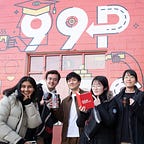Sprint 5: Optimizing HRI Research with Smart Guide — A Co-Design Journey
Written by the 2024 99P Labs x CMU MHCI Capstone Team
Edited by 99P Labs
The 99P Labs x CMU MHCI Capstone Team is part of the Master of Human-Computer Interaction (MHCI) program at Carnegie Mellon University.
Sneak Peek — Smart Guide Sprint 5 Progress
The “Smart Guide”
We envision our solution — the “Smart Guide” — as an AI research companion for HRI researchers, aimed at enhancing the efficiency of human-AI teaming (HAIT) research. The Smart Guide provides support to help researchers optimize their efforts and concentrate on fostering innovation. The ultimate goal is to bridge the gap between researchers’ endeavors and the overarching business objectives of HRI, facilitating the transformation of novel studies in HAIT into innovative products.
Goals for this week’s sessions
Taking a low-fidelity prototype of the Smart Guide, our goals for the week were to test whether this guide would prove valuable for researchers, by holding co-design sessions with CMU researchers and having them walk through their past work. Along the way, we would pose questions about what the Smart Guide might be able to do for them and identify any gaps in our prototype. Our guide was also put together with very high-level topics, and we planned to let researchers help us fill in the gaps and identify any considerations we did not take into account earlier.
During an in-class capstone critique session, we presented our prototype and testing session goals to our peers for feedback. We went over the capabilities we envisioned for our Smart Guide and explained the testing procedure we were envisioning with researchers.
This critique session helped us:
- Refined our ability to articulate concepts to audiences
- Solidified our protocol for activity with CMU researchers
- Helped us decide how to seek advice from experts
The Research Process
Our research process was significantly informed by a conversation with Jessica Hammer. We began by envisioning a Smart Guide with potential features but lacked a clear method for gathering insights with the Wizard of Oz technique. In our discussion with Jessica Hammer, we shared a linear prototype format that was inspired by an affinity diagramming methods session. This conversation validated some of our ideas and challenged others, guiding us toward a new approach for our prototyping session.
After our conversation, we returned to the drawing board to refine our product validation process. We began with two simple orange index cards and developed a set of central titles for our researchers to expand upon. We used a co-creation approach to shape our key objectives, understand how researchers work, and establish the sequence in which they navigate their mapping process.
One of the most important takeaways from our conversation, was that the research process is not a linear one. Instead, researchers begin at different points of a study, meaning that the modules of the project are equally important, forming a web order. This implies that our Smart Guide needs to tailor to the diverse needs and processes of a research study by accounting for a large amount of flexibility.
Prototype 2.0
Our prototype consists of a map made from a set of color-coded index cards. Orange cards represent the project, yellow cards denote sub-elements related to the research project, and green cards document expected outcomes from our researcher interviews.
The interview process was a collaborative session. In our initial round, we engaged with Carnegie Mellon researchers skilled in Human-AI teaming research. The protocol we maintained began by explaining the current status of our prototype. We then asked researchers to guide and map their research process using our current prototype. Our focus for this round was on pinpointing the factors that impact their decision-making throughout various stages of their research.
Insights
We gathered three key insights from these co-creation sessions that were compiled using an affinity diagramming team session:
Insight One: There is potential to gently nudge or provide suggestions to researchers to consider relevant aspects of testing when they conduct research in the field. Without dictating them to follow fixed methods, a more subtle approach provides a potentially more effective way to encourage researchers to consider field testing.
Insight Two: Surfacing a wide variety of content and multimedia types would be beneficial to researchers. Through interviews, we learned that research in different fields would benefit most from different types of figures. For example, Human-AI teaming metrics could be best paired with tables depending on varying scenarios, whereas uncovering methods could benefit more from diagrams.
Insight Three: Recognize the value of creating shareable blog content derived from ongoing research, accessible on both phones and laptops, to enhance dissemination and engagement.
Next Steps
Our interview sessions with CMU researchers have emphatically confirmed the value of our smart guide concept in enhancing their research-related searches. This is a thrilling milestone indicating that it’s the perfect time to advance! Looking ahead, we’re excited to pursue two dynamic directions:
- We plan to engage with HRI researchers to understand their process for searching relevant information for their projects. This will not only allow us to verify if our findings with CMU researchers extend to HRI, but also help us tailor the smart guide’s user flow to integrate seamlessly into the existing HRI workflows.
- We’re gearing up to develop an interactive prototype to meticulously explore the optimal flow and interactions for these types of search activities. This step is crucial in crafting an intuitive tool that meets the specific needs of our users and enhances their research efficiency.
Read Sprint 6 here!
